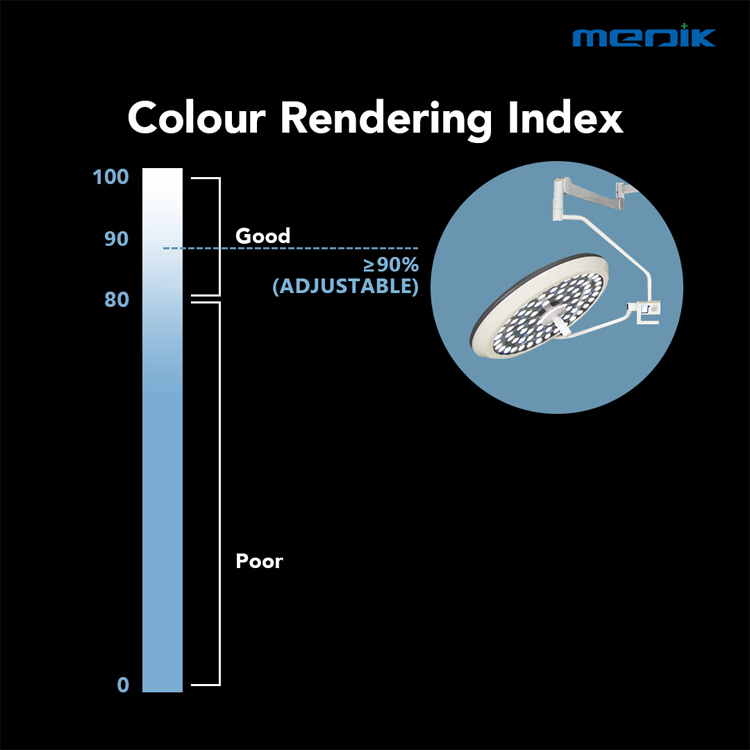

In this article, we'll be focusing specifically on LED lighting systems only. Since introduced into the medical equipment market 15 years ago, LED surgical lights have quickly outpaced older, halogen alternatives.
When shopping for surgical lighting, there are a few key terms you need to know: Illumination, color temperature, color rendition index, light field diameter, lifespan etc. In this article, we will learn more about the colour in surgical lighting.
1. Colour Temperature
What is Colour Temperature?
Color Temperature is the measurement of the light source’s color relative to an ideal light source. The unit of measurement for color temperature is Kelvin. The measurement of daylight color temperature is around 5,800 K. The IEC requires the color temperature of surgical lights to be within the 3,000–6,700 K range. These colors provide the surgeon with the truest tissue color rendition.
Cool colors in reducing eye fatigue
Colors over 5,000 K are higher on the Kelvin scale and are known as ‘cool’ colors, whilst colors of a lower value on the same scale are called ‘warm’ colors. The higher value light gives the appearance of blue-ish white. For longer surgeries, a 5,000 K light might also be preferred to reduce eye fatigue.
Bright, white, LED light
For many years, halogen bulbs were used in surgical theatres because they give off a higher level of whiteness than incandescent or conventional lights. However, halogen bulbs are still inherently yellow, with typical color temperatures around 3,200 K. Manufactures used to attempt at removing the yellow light using expensive coatings and filters, which managed to raise the color temperature to a more palatable level of around 4400 K. Although this process attempted to turn halogen lighting whiter, the color was still not desirable for optimal operation theatre procedures. In addition, the coatings and filters used were difficult to apply, hence the color variability between light heads was high. LEDs, on the other hand, can be engineered to produce white light at the preferred color temperature and no filters or reflective coatings are required to “correct” their color.
One of the most notable features of a high-quality LED surgical light is how white its color is. This is because it is critical to maintain optimal color temperature during surgery for surgeons to distinguish different tones of body tissues, flesh colors, and fluids. If the light were to have tones of other colors, it can be misleading, and change the appearance of the patient’s tissues. Being able to see the flesh's tone is vitally important to their work and patient safety.
2. Colour Rendition
What is Colour Rendition?
Color Rendition is the measure of the quality of light and it is often referred to as the color rendering index (CRI). The natural colors of an object are best visualized under bright daylight, which is used as a comparison to measure lighting devices. The CRI value of daylight is 100, and lights with “good” color rendition typically have a CRI of over 80. Often regular lighting can distort the color and appearance of objects, something that must be avoided during a surgical procedure. Therefore, the IEC has mandated that the color rendition index (Ra) for surgical lights needs to be between 85 and 100.

Why is R9 important in hospitals?
R9 is one of the colors that is not included in the measurement of CRI yet, whenever LED light quality is discussed, R9 matters. Some percentage of R9 is found in all of the colors that comprise the CRI value. But the specific ability of a lighting product to accurately reproduce red is critical to accurate overall color rendering.
Quality R9 is important in hospitals because it's the most critical color for surgical procedures. Visibility could be life-impacting. At R9 values of above 70, surgeons will immediately notice how red tones appear more bold and vivid, helping them make tissue identification and diagnosis faster and more accurate. Medical professionals need to be able to see all colors displayed properly during both surgeries and general medical procedures, so they can best serve their patients.
The Color Rendering Index and R9 values are two important features when it comes to selecting the right Surgical and Exam LED light for your application.
References
1. https://medicanix.com/news-and-blog/what-makes-surgical-lights-different-than-conventional-lights
2. https://insights.regencylighting.com/what-is-r9-color-rendering-value